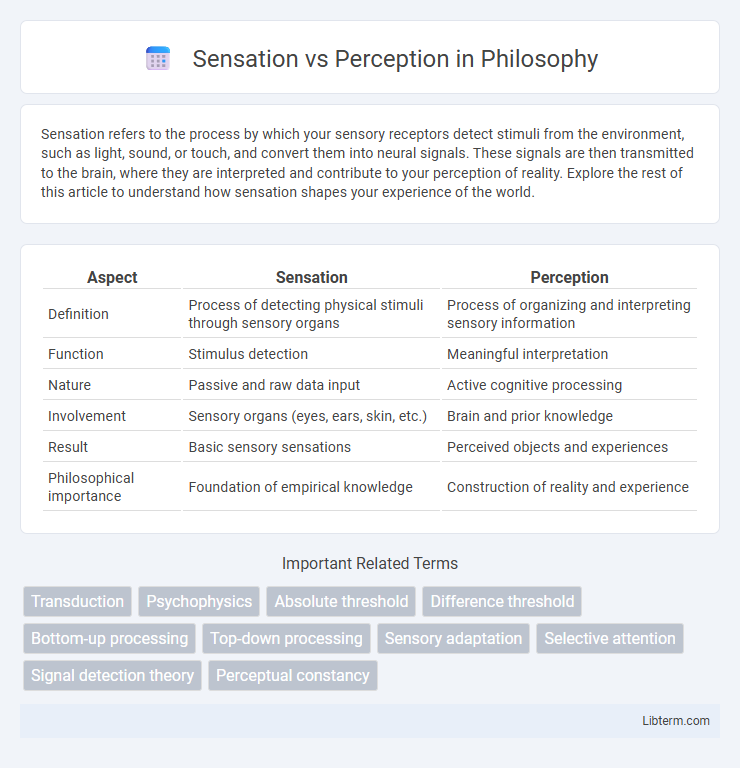Sensation refers to the process by which your sensory receptors detect stimuli from the environment, such as light, sound, or touch, and convert them into neural signals. These signals are then transmitted to the brain, where they are interpreted and contribute to your perception of reality. Explore the rest of this article to understand how sensation shapes your experience of the world.
Table of Comparison
| Aspect | Sensation | Perception |
|---|---|---|
| Definition | Process of detecting physical stimuli through sensory organs | Process of organizing and interpreting sensory information |
| Function | Stimulus detection | Meaningful interpretation |
| Nature | Passive and raw data input | Active cognitive processing |
| Involvement | Sensory organs (eyes, ears, skin, etc.) | Brain and prior knowledge |
| Result | Basic sensory sensations | Perceived objects and experiences |
| Philosophical importance | Foundation of empirical knowledge | Construction of reality and experience |
Introduction to Sensation and Perception
Sensation involves the process by which sensory receptors detect physical stimuli such as light, sound, or temperature and convert them into neural signals. Perception refers to the brain's interpretation and organization of these sensory inputs, allowing us to make sense of the environment. Understanding the distinction between sensation and perception is crucial for exploring how humans experience and interact with the world around them.
Defining Sensation
Sensation refers to the process by which sensory receptors detect and respond to external stimuli, such as light, sound, or temperature, converting these physical signals into neural impulses. It involves the initial detection and encoding of sensory information without interpretation or conscious awareness. Sensory receptors in organs like the eyes, ears, skin, and nose play a critical role in transducing environmental input for further processing in the brain.
Defining Perception
Perception is the cognitive process of organizing and interpreting sensory information to make sense of the environment. It involves higher-level brain functions that transform raw sensations into meaningful experiences, integrating past knowledge, expectations, and context. Unlike sensation, which is the passive reception of stimuli, perception actively constructs our conscious awareness of the world.
Key Differences Between Sensation and Perception
Sensation involves the detection of physical stimuli by sensory organs, converting environmental energy into neural signals, while perception refers to the brain's interpretation and conscious experience of those sensory inputs. Sensation is a passive process of collecting raw data, whereas perception is an active process influenced by past experiences, attention, and expectations. Key differences include sensation's reliance on sensory receptors and perception's dependence on cognitive functions such as recognition and contextual understanding.
The Sensory Process: How Sensation Works
Sensation involves the detection of external stimuli through specialized sensory receptors in organs such as the eyes, ears, and skin, converting physical energy into neural signals. These sensory receptors respond to specific types of stimuli--like photoreceptors for light, mechanoreceptors for pressure, and chemoreceptors for chemicals--initiating transduction processes that translate environmental information into electrical impulses. The neural signals travel via afferent pathways to the brain, where initial stages of processing prepare the data for higher-level interpretation during perception.
The Perceptual Process: How the Brain Interprets Sensations
The perceptual process involves the brain organizing and interpreting sensory input to create meaningful experiences from raw sensations. Sensory receptors detect stimuli, transmitting neural signals through the nervous system to the brain, where processes such as selection, organization, and interpretation occur. This complex interaction transforms basic sensory data into perception, enabling recognition, decision-making, and interaction with the environment.
Factors Influencing Perception
Perception is influenced by factors such as past experiences, cultural background, and cognitive biases, which shape how sensory information is interpreted. Attention and context play critical roles in filtering and organizing sensory input to form meaningful patterns. Neurological processes and emotional states further modify perception, leading to variations in how individuals perceive the same stimuli.
Real-World Examples: From Sensation to Perception
Sensation occurs when sensory receptors detect stimuli, such as the touch of a hot stove, while perception involves the brain interpreting that sensory information as pain and danger. For example, seeing a red traffic light is the sensation of light hitting the retina, while perceiving it as a signal to stop is the brain's interpretative process. In real-world scenarios, sensation provides raw data through sensory organs, and perception transforms this input into meaningful experiences, enabling appropriate behavioral responses.
Common Misconceptions about Sensation and Perception
Sensation and perception are often confused as identical processes, but sensation refers to the raw data received through sensory organs, while perception involves interpreting and organizing this sensory information in the brain. A common misconception is that perception is a passive reflection of reality, whereas it actively constructs meaning based on past experiences, context, and expectations. Sensory information can be accurate, but perception may vary significantly among individuals due to cognitive biases and neural processing differences.
The Importance of Sensation and Perception in Daily Life
Sensation and perception are critical for interpreting the surrounding environment and making informed decisions, enabling individuals to detect stimuli such as light, sound, and temperature through sensory organs. Accurate sensation allows for the initial detection of external cues, while perception organizes and interprets these signals to create a coherent understanding, essential for activities like driving, communication, and recognizing hazards. Impairments in either sensation or perception can significantly impact daily functioning, emphasizing their importance in maintaining safety, social interaction, and overall well-being.
Sensation Infographic

 libterm.com
libterm.com